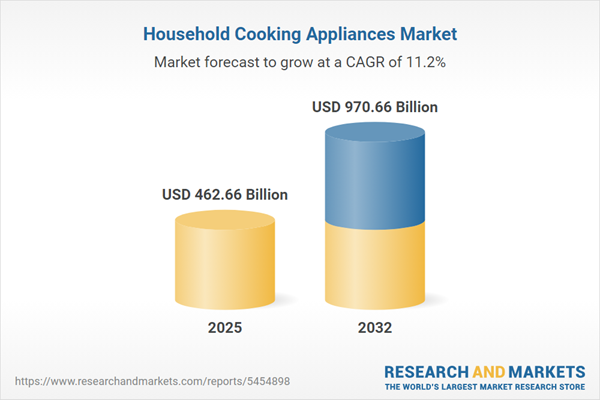Speak directly to the analyst to clarify any post sales queries you may have.
The household cooking appliances market is rapidly evolving as consumer expectations, technological advancements, and supply chain challenges redefine how products are designed and delivered. Senior decision-makers must navigate this transformation to sustain growth and maintain competitiveness in a complex global environment.
Market Snapshot of the Household Cooking Appliances Market
The household cooking appliances market grew from USD 416.53 billion in 2024 to USD 462.66 billion in 2025. The market is projected to expand at a CAGR of 11.15%, reaching USD 970.66 billion by 2032.
Key market drivers include increasing prioritization of energy efficiency and connectivity, as well as demand for integrated digital appliances across residential and commercial environments. Companies are adapting to new technologies and shifting trade dynamics while balancing legacy product lines.Scope & Segmentation of the Household Cooking Appliances Market
- Product Types: Cooker, Electric Cooktop, Gas Stove, Grill, Oven
- Technologies: Convection, Electric, Gas, Induction
- End Users: Commercial, Residential
- Distribution Channels: Offline (Department Store, Hypermarket & Supermarket, Specialty Store), Online
- Geographical Coverage: Americas (United States, Canada, Mexico, Brazil, Argentina, Chile, Colombia, Peru), Europe Middle East & Africa (United Kingdom, Germany, France, Russia, Italy, Spain, Netherlands, Sweden, Poland, Switzerland, United Arab Emirates, Saudi Arabia, Qatar, Turkey, Israel, South Africa, Nigeria, Egypt, Kenya), Asia-Pacific (China, India, Japan, Australia, South Korea, Indonesia, Thailand, Malaysia, Singapore, Taiwan)
- Companies Analyzed: Whirlpool Corporation, BSH Hausgeräte GmbH, Electrolux AB, Midea Group Co., Ltd., Haier Smart Home Co., Ltd., Samsung Electronics Co., Ltd., LG Electronics Inc., Panasonic Holdings Corporation, Miele & Cie. KG, Koninklijke Philips N.V.
Key Takeaways for Senior Decision-Makers
- Consumer demand is shifting towards smart, energy-efficient, and digitally integrated appliances, increasing the strategic value of induction and connected technologies.
- Manufacturers are redesigning products for modularity and repairability to align with evolving sustainability requirements and regulatory mandates across key regions.
- Diversified sourcing and the enhancement of supply chain resilience are crucial, reflecting a need for flexible procurement strategies and regional assembly infrastructure.
- Retail and distribution models are adapting, with a dual emphasis on immersive in-store demonstrations and richer online content to facilitate higher-value purchases.
- Aftermarket service models and value-added offerings are increasingly central to sustaining customer loyalty and enabling recurring revenues in both residential and commercial segments.
- Companies leveraging partnerships with software, utility, or home automation platforms are unlocking new routes to market and differentiation in bundled solutions.
Tariff Impact on Sourcing and Pricing Strategies
Recent trade measures have increased complexity for sourcing and pricing by affecting the cost structures for components and finished appliances. Strategic responses include supplier diversification, regionalized production, and tactical product redesign. Retailers are adopting selective price adjustments and service bundling to maintain competitive positioning while protecting margins.
Methodology & Data Sources
This research utilizes a mixed-methods approach, including interviews with executives, installers, procurement specialists, and policy advisors, combined with systematic analysis of specifications, patents, trade announcements, and public disclosures. Supply chain mapping and scenario-based validation provide additional layers of insight and rigor.
Why This Report Matters
- Enables senior leaders to align technology adoption and sourcing with current regulatory realities and long-term consumer trends.
- Presents clear, actionable segmentation for optimized investment and go-to-market strategy across geographies and channels.
- Supports operational resilience by spotlighting essential supply chain and product design adaptations for evolving market and trade demands.
Conclusion
Business success in the household cooking appliances sector will rely on coordinated innovation, resilient sourcing, and evolving channel strategies. Decision-makers leveraging these insights can capitalize on growth opportunities and drive sustained competitive advantage.
Additional Product Information:
- Purchase of this report includes 1 year online access with quarterly updates.
- This report can be updated on request. Please contact our Customer Experience team using the Ask a Question widget on our website.
Table of Contents
3. Executive Summary
4. Market Overview
7. Cumulative Impact of Artificial Intelligence 2025
Companies Mentioned
The companies profiled in this Household Cooking Appliances market report include:- Whirlpool Corporation
- BSH Hausgeräte GmbH
- Electrolux AB
- Midea Group Co., Ltd.
- Haier Smart Home Co., Ltd.
- Samsung Electronics Co., Ltd.
- LG Electronics Inc.
- Panasonic Holdings Corporation
- Miele & Cie. KG
- Koninklijke Philips N.V.
Table Information
| Report Attribute | Details |
|---|---|
| No. of Pages | 195 |
| Published | October 2025 |
| Forecast Period | 2025 - 2032 |
| Estimated Market Value ( USD | $ 462.66 Billion |
| Forecasted Market Value ( USD | $ 970.66 Billion |
| Compound Annual Growth Rate | 11.1% |
| Regions Covered | Global |
| No. of Companies Mentioned | 11 |









